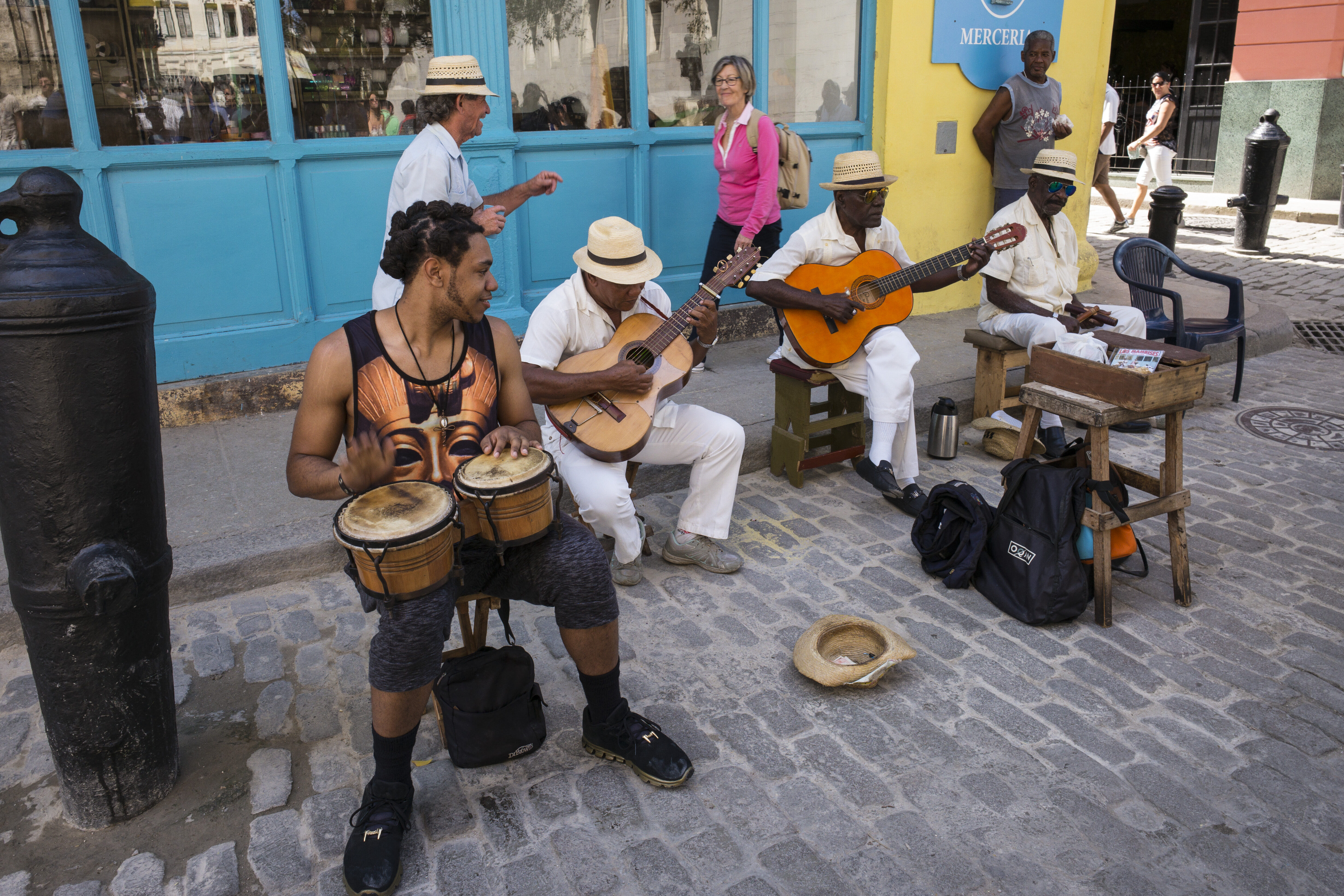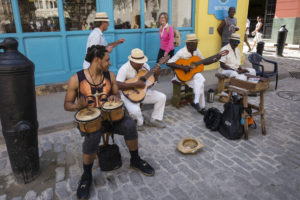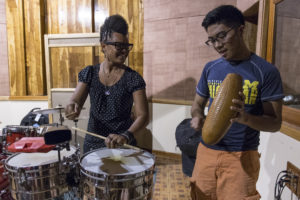
Student Michael Gardner plays bongos with a street band in Havana
Music is everywhere in Cuba. You hear it emanating from the densely packed apartment buildings, from the open-air restaurants and bars, from the never-ending stream of candy-colored vintage American cars that zip through the broad cosmopolitan boulevards of Havana and snake through the narrow cobblestoned lanes of Trinidad.
But most memorable is the live music, performed day and night in cities large and small. On a single street in Havana, you might encounter several solo buskers—perhaps a trumpeter, a guitarist, and a flutist—each staking out their own small piece of real estate. And in parks and squares throughout the country you’ll find ensembles entertaining mixed crowds of tourists and Cubans, with all ages and ethnicities dancing, swaying, clapping, and singing along.
The styles may vary—Cuba’s musical heritage is rich in variety and includes rumba, salsa, son cubano, jazz, reggaeton, and more—but ubiquitous are the percussionists: the drivers of the rhythm that is the beating heart of Cuba.
For a student of jazz percussion, Cuba is the holy grail of influence. The rhythms, instruments, and techniques that began in this small country—from the unique melding of Spanish and African traditions—have created some of the world’s most influential regional music. All jazz percussionists study the Cuban masters, mainly by listening to recordings and watching videos. But the opportunity to hear and see these artists in person—and to actually study and perform with them—is rare.
But that’s exactly what 12 SMTD jazz students did over spring break this year, thanks to the generosity of an anonymous donor. For one week, the students—10 percussionists, one bassist, and one pianist—toured the country, learning about its history, religion, economics, politics, art, and, of course, its music.
Led by Michael Gould, professor of music (jazz percussion) in SMTD’s Department of Jazz and Contemporary Improvisation, the bus tour included three days in Havana followed by stops in Cienfuegos, Trinidad, Matanzas, and Varadero. Joining Gould were Jonathan Ovalle, assistant professor of percussion, and Robert Hurst, associate professor of jazz and contemporary improvisation (bass).
“Because we study the music of other cultures so much, we need to get our feet on the ground and see the actual masters performing in their hometowns,” Gould said. “And we need to get not only the sounds, but the sights and the smells.”
That immersive experience is exactly what made the trip so stimulating for junior Everett Reid, a dual major in jazz and performing arts technology. “Cuba has fueled my creative process; it’s a whole different amalgamation of stimuli that I wouldn’t otherwise get in the U.S.,” he said. “Being in a completely foreign environment, hearing a different language all the time, tasting different foods, hearing completely different music than I’d hear in the States: it’s just fuel for a completely different direction of creative thought.”
Gould says that the rich musical legacy of Cuba is best experienced in person, especially for aspiring jazz musicians. “It’s one thing to study the music, but it’s another thing to actually be here, and talk to the individual players and meet the up-and-coming musicians,” he said.
“This is the where these rhythms are played authentically,” said Kayvon Gordon, a junior. “There are musicians in New York, Brooklyn, Miami, but Cuba is where all the rhythms originated, where they were born. I think it’s necessary for one who wants to study the music to go to the source.”
Havana
Cuba’s capital and largest city, Havana, was the first stop for the SMTD group, which toured the expected spots—Old Town, Museum of the Revolution, El Morro Castle, and the Tropicana nightclub (an incredible throwback to the Havana’s glamorous pre-revolution heyday). All offered invaluable context, history, and insight into the political and cultural forces that have formed today’s Cuba. But the most trenchant experiences were the musical ones, and they took place daily.
A first-day highlight for the group was a visit to Fábrica de Arte Cubano (Factory of Cuban Art), known as “The F.A.C.,” a cutting-edge gallery and performance space located in a former cooking oil factory. The facility also includes El Cocinero, one of the city’s top restaurants, where the group dined.
The F.A.C. presents an onslaught of visual and aural artistry: a warren of rooms, most hung with works by some of by Cuba’s most innovative artists, and larger spaces featuring music acts, performance art, and video installations, often simultaneously. It provided an unexpected introduction to the city; no one knew that Havana was such a hip and art-centric place, teeming with creativity and vibrant with outsider and street art.
The following morning was spent on a walking tour of Old Havana, the historic part of the city that dates back to the 16th century and is now a UNESCO World Heritage site; it is one of 11 in Cuba, which has been minimally touched by modern development as a result of the politics and policies of the last 60 years.
Amid the rich history and beautiful architecture (some of it crumbling or undergoing various states of renovation), traditional music began to be experienced; it offered the first opportunity for interaction when one of the students jumped in to play bongos with a street band and was warmly welcomed.
“In jazz, sitting in with the band is part of the tradition,” Gould said. “In Cuba, if you say you want to play, the musicians welcome you with open arms, and they’re so excited that you’re not only a musician from elsewhere, but also have a few tidbits of knowledge about their music. When you’re able to communicate like this, it just drops all barriers.”
Later in the day, the group visited Callejon de Hamel, an alley that is home to a rumba concert every Sunday. With tall buildings rising on either side—most decorated with colorful murals—this thoroughly authentic experience (the audience was almost entirely Cuban) proved to be one of the most memorable for many students and faculty.
“I cannot stress how unbelievable the playing was,” Gould said. “It featured some of the best drummers and singers in Havana. I had goosebumps listening to them and watching the students absolutely freak out—they were jumping up and down and dancing. They said that if this was all they experienced, they would be happy.”
“We were all really scrunched in,” said senior David Alvarez. “I saw a little baby, being carried by the mom, and she had a little thing to cover the baby’s ears. But that was like the definition of immersion to me—being exposed at such a young age. I felt like that little infant—I’m so new to the culture and that experience was incredible.”
More music was in store that night, following dinner, when the students stopped by an open-air music venue. Students and professors both, sat in with the band, taking turns playing claves, congas, bongos, güiro, maracas, and more.
The following morning, students had the opportunity of taking a clinic with Yissy Garcia, a young female percussionist considered at the vanguard of mixing jazz, pop, and hip-hop with rumba, reggae, funk, and electronic music to create a fresh new approach to Cuban jazz (she currently tours with Dave Matthews.) Gould had met the artist in Ann Arbor at the Kerrytown Concert House last year, where he initiated the plan for the master class, which also featured conga player Maripaz, also a woman. It’s not typical for women to be percussionists in Cuba, where the Abakuá religion, brought from Africa, forbade them from playing the instruments. But those taboos are fading and these dynamic young women taught a lively class in which the students learned basic Cuban rhythms on a series of instruments.
Following lunch, the group visited the Universidad de las Artes (ISA), whose curriculum includes music, theater, dance, and the visual arts. The historic university, founded by Fidel Castro and Che Guevara, is situated on the grounds of a former country club and features some of Cuba’s most significant modern architecture, though much of it is in a state of disrepair.
The U-M students enjoyed an impressive concert by the ISA students, who effortlessly moved from piano to conga to clarinet to bass, showing masterful dexterity at all instruments and dazzling their American audience. Some of the SMTD students also performed, and others sat in with the ISA students. They were thrilled when Gould and ISA’s dean broached the subject of creating an exchange program with SMTD.
The next musical experience also made a deep impression. At the Regla Museum, across the Bay of Havana, a private Santería concert was performed by drummers and singers, while dancers depicted many of the religion’s saints, or orishas (spirits). Santería was brought to the New World by the enslaved people of Yoruba, who syncretized it with Roman Catholicism to shield their traditional beliefs.
“It was an unparalleled experience,” said Michael Gardner, a junior. “I’ve never felt as close to my culture as I have here. Hearing about all the parallels between the Santería religion, traditional Yoruba religion, and Catholicism, and the way these Africans used their ingenuity to practice their religion—it was super meaningful to me.”
That evening, the students had the honor of visiting with Jeffrey DeLaurentis, the first U.S. ambassador to Cuba since 1961. DeLaurentis and his wife Jennifer welcomed the Michigan contingent to their home, where he shared an overview of his role and the current status of American and Cuban diplomatic relations. The group also had a chance to tour the beautiful grounds of the residence, located in the most exclusive area of the city. The visit concluded with an impromptu performance by senior Molly Radosevich, who played a jazz standard on the grand piano in the home’s elegant foyer.
“It wasn’t a planned performance, which made it even more exciting,” Radosevich said. “It was definitely an experience I’ll never forget.”
Trinidad
Located on the central southern coast of Cuba, Trinidad is one of the oldest and best-preserved cities in the country, and another UNESCO World Heritage Site. Founded in 1514, the city is completely cobblestoned and full of Spanish colonial plazas, mansions, and churches. It has become a major tourist destination, with its old-world charm and nearby Caribbean beaches, but music is also a major draw.
After dinner—during which they were serenaded by a guitar duo—the students descended on the town square where live music is performed nearly around the clock. That night featured a band playing “son Cubano,” the style of music made internationally famous by the Buena Vista Social Club. It was a classic Cuban experience—a warm night under the stars, a historic square, and a large appreciative audience of locals and tourists.
“Something that surprised me on this trip has definitely been the large groups of Cubans that participate in the music—it really reaches everybody,” said senior Cory Tripathy. “I come from the jazz community, which is such a small group. But here everybody seems to appreciate and take part in the music.”
Following a walking tour of Trinidad in the morning, including an eye-opening visit to a typical Cuban ration store, the students returned to the square. This time several sat in with a classic salsa band, playing various percussion instruments. Then it was off to the final stops, Varadero and Matanzas, and the highlight of the week: meeting, learning from, and playing with Cuba’s most celebrated rumba band.
Los Muñequitos de Matanzas
Cuban rumba is in a class of its own. It is percussion-driven music, accompanied by song and dance that exudes the physical and emotional intensity of its African roots. Although the ballroom dance (more commonly spelled “rhumba”) took its name from the style, and also originated in Cuba, it shares little else with the thrilling, frenetic, and blood-thumping music that made “rumba” synonymous with “party.”
A synthesis of various African traditions and Spanish influences, rumba became the music of the country’s poorest people, with its beginnings in Havana and Matanzas, a port city on the northern coast. It was there that Los Muñequitos de Matanzas was founded, in 1952, in a tavern where their “instruments” were the bar’s counter, tables, glasses, and bottles. The group has since become not only one of Cuba’s most famous rumba bands, but also one of the most admired and beloved. They have recorded continuously since 1956, with new members regularly joining as older ones retire.
After six days of nonstop consumption of Cuban culture, the SMTD students ended their trip in Matanzas with an extraordinary, life-changing experience: a private performance by Los Muñequitos de Matanzas, in the band’s educational studio space, followed by a master class.
The experience proved to be highly emotional. “I was almost crying when the Muñequitos musicians were playing all these different type of rumbas,” Alvarez said. “I really felt the culture thriving, and everyone’s spirits were so lifted up. That’s one of the things you can’t get in a textbook or from a professor. When you fuse knowledge with feelings and are able to integrate it with your emotions, that enhances your understanding and appreciation so much.”
The students and faculty were introduced to the Muñequitos by Carol Steele, an American percussionist who has known and played with the band for 30 years and now arranges classes for visitors to the island nation. The master class took place a few blocks away from the studio in the home of a former famous rumba singer, who served a traditional homemade lunch of rice, beans, and chicken. Her 10 x 10-square-foot kitchen was then cleared out, and the students, faculty, and Muñequitos instructors moved in.
It was crowded, it was hot, but there wasn’t a hint of complaint. Instead, there was elation. The students received a priceless lesson in technique and rhythm from the younger Muñequitos, keeping with the band’s tradition of having all members learn how to teach the music, to insure that it will be passed on.
“This was such an important culmination of the trip,” said Gould. “For me, it was hard not to tear up as I have been listening to the Muñequitos for over 20 years. The students were so blessed to experience this group firsthand and witness one of Cuba’s national treasures in, literally, their own home. I think most everyone who was on the trip wants to go back and study with them again someday soon.”
“The rumbas—both Los Muñequitos and the rumba in the alley—have been absolutely mind-blowing,” Reid said. “I’m kind of adapting that to my own artistic thought and my own composition-generation in my mind—I’m making it my own by hearing the rhythms that they’re playing and adapting them to my own sound in electronic music.”
“Sitting next to and playing with the Cuban musicians helped me capture the intricacies of what they’re doing,” Tripathy said. “Participating in it this way feels a lot different; you can really feel your own place within the music.”




